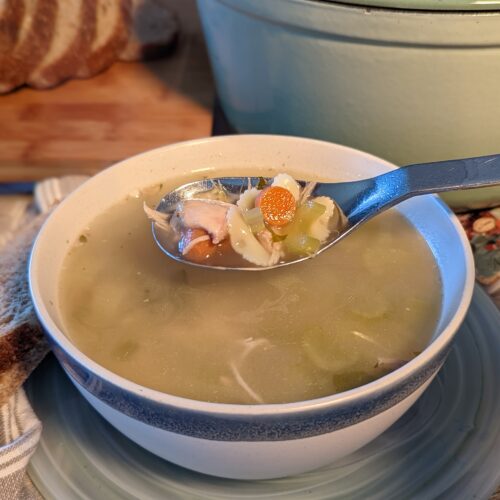
Homemade Chicken Soup
Homemade chicken soup is exponentially more than the sum of its parts. Yet, each part plays a critical role in contributing its flavour, colour, and mouth feel! While your own creativity and preferences will guide the process, I'm sharing what I consider to be the fundamentals of building a rich flavourful lightly-coloured broth that boasts chunky pieces of chicken and a colourful medley of traditional vegetables. The Italian influence of adding a piece of Parmigiano Reggiano rind lends a subtle but detectable undertone. While not my mom's practice, my mother-in-law would occasionally add it. Consider the list of ingredients as a guide, including the rind. You decide on what and how much to include. All you really need to understand is that a high ratio of meat with bones to water will create a deeply satisfying nutritious all-natural broth. There's no real rule because the end result is more a reflection of your preferences. I tend to fill a large pot with chicken parts (sometimes I even add a couple of veal or beef bones) and cover with cold water by a few inches. Another guide is to use 2 pounds meat/bones with 1 quart water. While not necessary, using organic chicken adds a noticeable difference and just makes me feel like I am indulging in something more wholesome. You could use boneless chicken but you'll miss the gelatin, minerals, and other nutrients stored and released by the bones. Even the chicken skin contributes valuable collagen which causes the broth to become gelatinous once refrigerated. Adding vegetables to the pot adds more flavour but you may decide to not add any vegetables at all! My mom added only a carrot, one little sprig of parsely, and a few tiny pieces of raw tomato. That's it! And her chicken soup was the tastiest broth that I ever had!Just the thought of having a large pot of simmering soup on the stove offers comfort and security! How long should it simmer? Again, there is no rule! I tend to simmer for a couple of hours. I have to admit that sometimes I've simmered the soup so long that there is very little broth left! While not ideal, I just added more water! Finally, be sure to taste for salt. Even the richest broth can taste bland without enough salt. After you try this recipe, you'll probably never purchase a box of store-bought stock again! And those salty little cubes of bouillon serve no purpose other than to spoil the natural flavours of these simple ingredients with its high sodium and additives!Because these proportions make a large batch, either enjoy as leftovers for a few days or freeze in convenient portion sizes for those days where only a hot bowl of homemade soup will hit the spot. Freeze with or without the pasta.
Prep Time 10 minutes mins
Cook Time 2 hours hrs
Total Time 2 hours hrs 10 minutes mins
Course Brunch, dinner, Lunch, Main Course, Soup
Cuisine American, Italian
Servings 12 servings
Ingredients
Stock Ingredients
- About 4lb whole chicken (giblets removed and discarded) or combination of chicken parts (necks, backs, wings, thighs, legs, breasts)
- 12 - 16 cups cold water
- 3 ribs celery
- 1 large cooking onion
- 1 large whole carrot
- ½ bunch parsley
- 5-8 whole peppercorns
- 2-3 whole dried bay leaves
- 3 inch piece of rind from Parmigiano Reggiano rind, lightly scraped and rinsed
Soup Ingredients
- 5 ribs celery, thinly sliced or diced
- 1 large carrot, thinly sliced or diced
- ½ bunch parsley, chopped
- 1 large onion, diced or bunch of green onion, sliced
- ½ - 1 cup small pasta type (farfalline, orzo, etc.) or broken long pasta like fettucine or spaghetti
- Parmigiano Reggiano, grated, to taste
- salt and pepper, to taste
Instructions
How to make the broth:
- Wash the whole chicken or chicken pieces well. If using a whole chicken, cut off the tail end. Place in a large deep pot (about 7 to 8 quart volume) and fill with enough cold tap water to cover the chicken by 1 or 2 inches. If using 4 pounds of chicken, add about 4 quarts water.
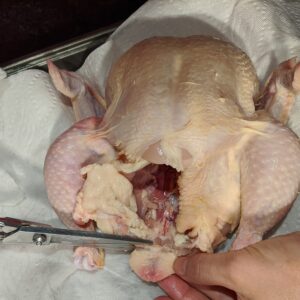
- Place over medium-high heat to bring to a boil. Use a sieve to remove the scum that rises to the surface and discard. Add the rest of the broth ingredients. Lower the heat to maintain a simmer, not boil. Partially cover and let cook for about 90 - 120 minutes. If too much liquid is evaporating, add a little more water.
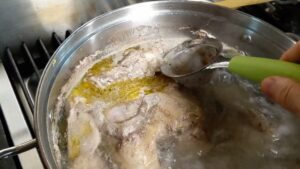
- Remove the pot from heat. Using a flat metal strainer, carefully lift the chicken or chicken pieces out of the pot and place in a large bowl to cool slightly. Strain the broth into another pot to catch the vegetables and any debris from the bones. Discard the vegetables. The Parmigiano Reggiano rind can be reserved (either whole or chopped) for the broth and served with the soup; otherwise, discard it. See below how to defat the broth. (At this point, this broth is more accurately labelled a stock. You can let it cool and then freeze to use in other recipes like risotto).
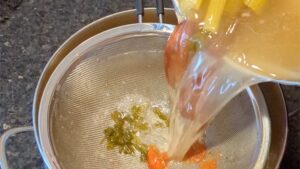
- Once the meat is cool enough to handle, use your fingers or two forks to remove the meat from the bones. You can use all the meat to add to the broth or you may decide to reserve some of it to make chicken salad or chicken pot pie. Either dice or shred the chicken and place it in a bowl. Use some of the broth to keep it submerged. Set aside.

How to make the soup:
- About 30 minutes before serving the soup, place the defatted broth on medium heat and bring to a simmer. Add the chicken meat and soup vegetables (celery, carrot, onion, and parsley) and rind (if you are going to eat it). Cook until the vegetables are tender, about 20 minutes. Add salt to taste. Be sure to season generously.
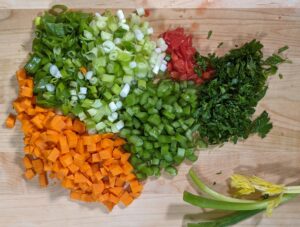
- About 10 minutes before serving, cook the pasta in a separate pot. Follow the instructions on the package but remove from heat a few minutes before fully cooked. Strain the pasta and add to the simmering pot of broth and vegetables. Bring to a boil. Adjust seasonings.
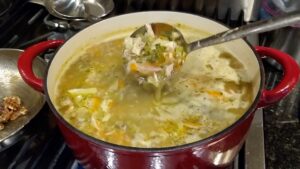
- Serve with black pepper and freshly grated Parmigiano Reggiano.
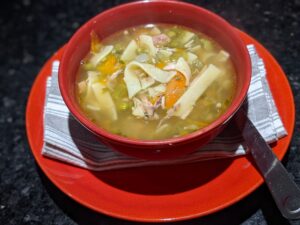
Video
Notes
While not my practice, some people add the giblets to the water to prepare the stock.
Use your own creativity to guide the types of vegetables you would like to add to the stock/broth. Decide whether you would like to dice, cube, or shred the vegetables and meat. The herbs, dried or fresh, can vary depending on your preference and availability. If you like a heartier soup, be generous with the meat and vegetables.
To defat the broth, allow it to come to room temperature and then refrigerate. Once cold, any fat will solidify on the surface. It can be easily removed with a spoon and discarded. If using the broth immediately, spoon off as much of the floating fat as possible. Another option is to pour the soup in a fat separator, a little at a time, and then pour it back into a pot.
For a very economical version of this soup, reserve the bones from a roast chicken dinner to build the stockpot. Once the roast chicken is fully cooked, debone it and serve the meat as part of your dinner. The bones (and any remaining meat) including the skin and roasting vegetables can be added to a pot, covered with cold water, and brought to a simmer, as in the first half of the recipe.
If you would like to simplify one of the steps, you can cook the pasta directly in the broth, following the directions on the pasta package. Note that this method will turn the soup cloudy. It will not spoil the soup but it will lightly thicken it because of the starch in the pasta.
Keyword chicken, soup, vegetables